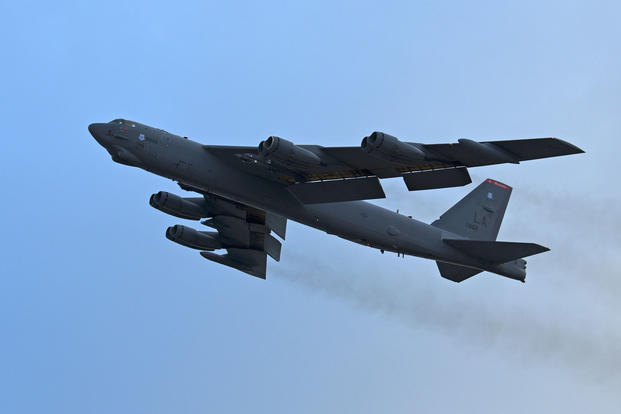North Korea cited the presence of B-52s in joint military exercises with South Korea as a reason for threatening to pull out of peace talks, but the Pentagon denied the strategic bombers are taking part in the annual Maximum Thunder drills.
"B-52s were never scheduled to be a part of Max Thunder," a Pentagon spokesman said Wednesday of the exercises that began last Friday and are expected to run through May 25.
The North's Korean Central News Agency propaganda outlet charged Wednesday that the annual Maximum Thunder air exercises included "over 100 fighters of various missions, including B-52 strategic nuclear bombers and F-22 Raptor stealth fighters under the supervision of the U.S. imperialist aggressor forces."
The usually bombastic KCNA, which had previously toned down the rhetoric ahead of the planned summit between President Donald Trump and North Korean leader Kim Jong-un, has traditionally labeled U.S.-South Korea military exercises such as Foal Eagle, Key Resolve and Maximum Thunder as practice for an invasion.
KCNA called the Maximum Thunder exercises "the largest-ever and a reflection of the invariable stand of the U.S. and South Korea to persist in the 'maximum pressure and sanctions' against the DPRK [Democratic People's Republic of Korea]."
B-52s were not part of the Maximum Thunder drills last year, according to an Air Force release.
In a statement Tuesday in response to the North Korean charges, Col. Rob Manning, a Pentagon spokesman, stressed that Maximum Thunder is a defensive drill but did not disclose the types of aircraft taking part.
"While we will not discuss specifics, the defensive nature of these combined exercises has been clear for many decades and has not changed," he said.
South Korea's Defense Ministry said Wednesday the two-week Maximum Thunder exercises, which began last Friday, would continue despite protests from North Korea.
The ministry made no mention of B-52s, but said the exercise involves about 100 aircraft, including eight F-22 Raptors, and is a joint operation of South Korea's Air Force Operations Command and the U.S. 7th Air Force.
"The exercise will proceed as planned, and regarding that, there are no differences between South and the U.S.," the ministry said. In addition, "the exercise is designed to enhance the capability of pilots and is not an implementation of an operational plan or an attack maneuver."
South Korea's Yonhap news agency, citing sources, said B-52s had not yet participated in Maximum Thunder and "it appears that the B-52 might not attend the exercise."
In contrast to previous years, the U.S. and South Korea have taken a low-key approach to their joint military exercises and limited their duration and scope during the apparent thaw with North Korea, which is expected to lead to the summit between Trump and Kim on June 12 in Singapore.
U.S. Defense Secretary Jim Mattis postponed the annual Foal Eagle exercises involving thousands of U.S. and South Korea troops during the Winter Olympics and Paralympics in South Korea. When they resumed, the usually two-month-long Foal Eagle exercises were cut to one month.
In response to the Maximum Thunder exercises, North Korea canceled scheduled meetings with South Korean officials Wednesday at Panmunjom on the Demilitarized Zone that were expected to work out details on the Trump-Kim summit.
In a statement, South Korea's Unification Ministry said, "It is regrettable that the North's unilateral move to postpone the high-level inter-Korean talks, citing the annual South Korea-U.S. air drills, does not conform with the spirit and purpose of the agreements" previously announced by Kim and South Korean President Moon Jae-in.
-- Richard Sisk can be reached at Richard.Sisk@Military.com.













